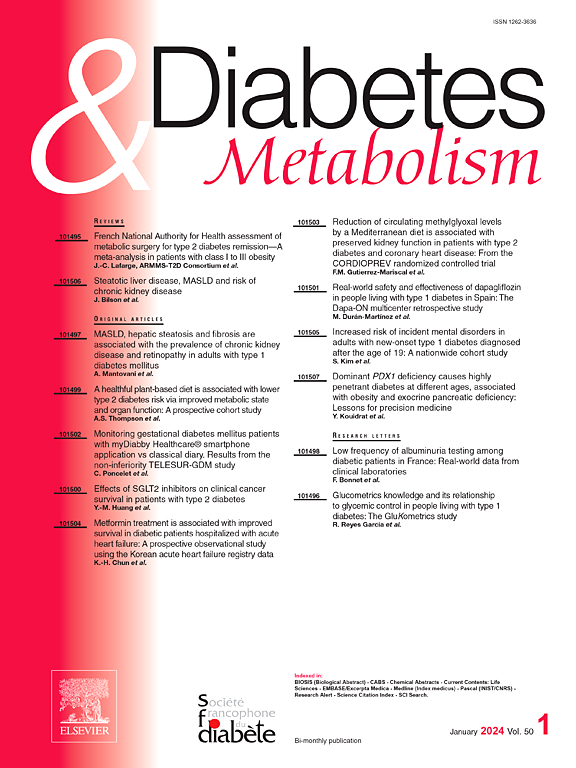One-hour post-load glucose is associated with biopsy-proven metabolic dysfunction-associated steatotic liver disease in obese individuals
IF 4.7
2区 医学
Q1 ENDOCRINOLOGY & METABOLISM
引用次数: 0
Abstract
Aim
To investigate the association between one-hour post-load plasma glucose (1h-PG) levels and metabolic dysfunction-associated steatotic liver disease (MASLD) and metabolic-associated steatohepatitis (MASH).
Methods
Clinical data were collected from 538 obese participants who underwent oral glucose tolerance tests (OGTT) and liver biopsy in the Drum Tower Hospital affiliated with the Nanjing University Medical School. Participants were categorized into normal glucose tolerance (NGT), prediabetes (pre-DM), and type 2 diabetes (T2DM) groups, with further stratification of the NGT group into 1h-PG Low and 1h-PG High. The diagnosis of MASLD and MASH was performed using the NASH Clinical Research Network scoring system. Logistic regression analyses were performed to determine the association between each category and MASLD/ MASH.
Results
The prevalence of MASLD and MASH progressively increased across NGT 1h-PG Low, NGT 1h-PG High, pre-DM and T2DM groups. Compared to the NGT 1h-PG Low group, the NGT 1h-PG High group had a significantly higher risk of MASLD (OR 3.27 [95 % CI 1.32;8.09]) and MASH (OR 3.08 [1.55;6.11]), which is similar to the pre-DM group. Additionally, elevated 1h-PG levels were associated with hepatic steatosis, lobular inflammation, and fibrosis. Mediation analysis indicated that Matsuda insulin sensitivity index and disposition index played a sequential mediating role between 1h-PG and hepatic steatosis, accounting for 14.23 % of total effect (β 0.014 [95 % CI 0.002;0.035]).
Conclusion
Elevated 1h-PG levels increase the risk of MASLD and MASH in obese individuals. Early screening and management of MASLD are necessary, even in NGT individuals when 1h-PG levels are ≥8.6 mmol/l.
肥胖个体1小时负荷后葡萄糖与活检证实的代谢功能障碍相关的脂肪变性肝病相关
目的:探讨负荷后1小时血浆葡萄糖(1h-PG)水平与代谢功能障碍相关脂肪性肝病(MASLD)和代谢相关脂肪性肝炎(MASH)的关系。方法:收集南京大学医学院附属鼓楼医院538例接受口服糖耐量试验(OGTT)和肝活检的肥胖患者的临床资料。参与者被分为正常糖耐量(NGT)组、糖尿病前期(糖尿病前期)组和2型糖尿病(T2DM)组,并将NGT组进一步分为h- pg低组和h- pg高组。MASLD和MASH的诊断采用NASH临床研究网络评分系统。进行逻辑回归分析以确定每个类别与MASLD/ MASH之间的关系。结果:在NGT 1h-PG低、NGT 1h-PG高、糖尿病前期和T2DM组中,MASLD和MASH的患病率逐渐增加。与NGT 1h-PG低组相比,NGT 1h-PG高组MASLD (OR为3.27 [95% CI 1.32;8.09])和MASH (OR为3.08[1.55;6.11])的风险明显高于糖尿病前期组。此外,1h-PG水平升高与肝脂肪变性、小叶炎症和纤维化有关。中介分析显示,松田胰岛素敏感指数和体质指数在1h-PG与肝脂肪变性之间起序列中介作用,占总效应的14.23% (β 0.014 [95% CI 0.002;0.035])。结论:肥胖者1h-PG水平升高可增加MASLD和MASH的发生风险。早期筛查和管理MASLD是必要的,即使在1h-PG水平≥8.6 mmol/l的NGT个体中也是如此。
本文章由计算机程序翻译,如有差异,请以英文原文为准。
求助全文
约1分钟内获得全文
求助全文
来源期刊

Diabetes & metabolism
医学-内分泌学与代谢
CiteScore
12.00
自引率
4.20%
发文量
86
审稿时长
13 days
期刊介绍:
A high quality scientific journal with an international readership
Official publication of the SFD, Diabetes & Metabolism, publishes high-quality papers by leading teams, forming a close link between hospital and research units. Diabetes & Metabolism is published in English language and is indexed in all major databases with its impact factor constantly progressing.
Diabetes & Metabolism contains original articles, short reports and comprehensive reviews.
 求助内容:
求助内容: 应助结果提醒方式:
应助结果提醒方式:


